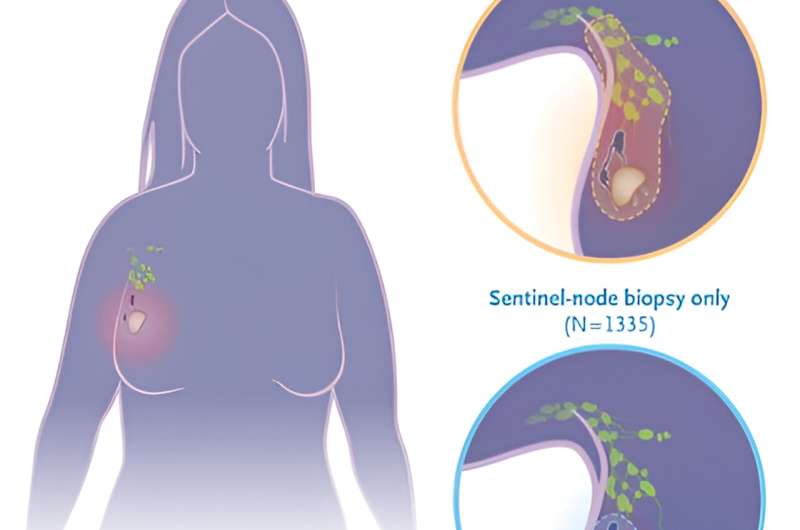This article has been reviewed according to Science X's editorial process and policies. Editors have highlighted the following attributes while ensuring the content's credibility:
fact-checked
peer-reviewed publication
trusted source
proofread
Clinical trial: Less extensive breast cancer surgery results in fewer swollen arms

It is possible to leave most of the lymph nodes in the armpit, even if one or two of them have metastases larger than two millimeters. This is shown in a trial enrolling women from five countries, led by researchers at Karolinska Institutet and published in the New England Journal of Medicine. The results open up for gentler surgery for patients with breast cancer.
Breast cancer can spread to the lymph nodes in the armpit. However, tumors found only in the breast and armpit lymph nodes are considered a localized disease, with the goal of curing the patient.
A challenging question for breast cancer surgeons revolves around what should be done when patients have metastases in the armpit, first detected during examination of tissue removed during surgery.
Performing a so-called axillary dissection (removing many lymph nodes in the armpit) increases the risk of arm lymphedema. This occurs when lymph fluid cannot flow as freely as before, resulting in swelling in the arm and potentially causing pain and restriction of mobility.
"We want to perform less extensive procedures to spare patients from troublesome side effects. But we need to know that it's safe," says Jana de Boniface, breast cancer surgeon at Capio S:t Görans's Hospital and researcher at the Department of Molecular Medicine and Surgery at Karolinska Institutet.
When it is known before the breast cancer surgery that there are metastases in the armpit, different treatment paths are chosen. Those patients are not included in this trial.
However, when no lymphatic spread is suspected, the surgeon usually removes the so-called sentinel lymph nodes (the node or nodes first reached by lymph fluid from the breast).
Safe to leave lymph nodes
If these contain single tumor cells or metastases that are a maximum of 2 millimeters in size, the rest of the lymph nodes in the armpit are left intact. Previous trials have shown that this is safe for the patient.
Now, a large trial led from Karolinska Institutet has clarified the situation even for larger metastases. It includes nearly 2,800 patients from five different countries. All had metastases larger than 2 millimeters, so-called macrometastases, in one or two sentinel lymph nodes.
After sentinel node surgery, the patients were randomly assigned to undergo a completion axillary dissection (previously standard practice for all) or to leave the rest of the armpit undisturbed.
Nearly all patients received some postoperative treatment with chemotherapy and/or anti-hormonal therapy, plus radiation therapy according to guidelines in each respective country.
More than one-third of patients who underwent axillary dissection were found to have additional metastases than the maximum two in the sentinel lymph nodes.
Postoperative treatment sufficient
This must be assumed to be the same for those who kept the remaining lymph nodes. Still, recurrences were equally common in both groups, indicating that postoperative treatment seems sufficient to eliminate remaining tumor cells.
At the same time, a previous publication from the trial showed that 13% of those who underwent axillary dissection reported serious or very serious problems with their arm function, compared to 4% among those who only had the sentinel lymph nodes removed.
"Our assessment is that it is safe for patients to forgo axillary dissection if there are a maximum of two macrometastases in the sentinel lymph nodes. In these cases, axillary dissection is replaced with radiation therapy to the armpit, which results in less arm-related complications. This has now been implemented in clinical practice in Sweden," says Jana de Boniface.
More information: Jana de Boniface et al, Omitting Axillary Dissection in Breast Cancer with Sentinel-Node Metastases, New England Journal of Medicine (2024). DOI: 10.1056/NEJMoa2313487
Kandace P. McGuire, Axillary Dissection — The Bell Tolls for Thee, New England Journal of Medicine (2024). DOI: 10.1056/NEJMe2401805
















